现在准备研究1些源码或框架,但是1些基础的知识1定要懂,不然没法看,比如设计模式,java基础中的反射,泛型,注解,多线程,线程池,队列等,现在很多框架都是这些知识杂糅而成的,
我们经常使用的java内置3大注解:
public class MainActivity extends AppCompatActivity { @Override protected void onCreate(Bundle savedInstanceState) { super.onCreate(savedInstanceState); setContentView(R.layout.activity_main); } }
上面onCreate()方法上@Override就是注解,我们点击进去看看,
package java.lang; import java.lang.annotation.*; /** * Indicates that a method declaration is intended to override a * method declaration in a supertype. If a method is annotated with * this annotation type compilers are required to generate an error * message unless at least one of the following conditions hold: * * <ul><li> * The method does override or implement a method declared in a * supertype. * </li><li> * The method has a signature that is override-equivalent to that of * any public method declared in {@linkplain Object}. * </li></ul> * * @author Peter von der Ahé * @author Joshua Bloch * @jls 9.6.1.4 Override * @since 1.5 */ @Target(ElementType.METHOD) @Retention(RetentionPolicy.SOURCE) public @interface Override { }
@interface就是表明声明1个注解类,在java.lang包下,发现声明的注解Override上面有2个@Target和@Retention这2个注解,
@Target(ElementType.METHOD) 表示注解类(Override)使用再方法上
@Retention(RetentionPolicy.SOURCE) 表示使用再源码中
@Target说明了Annotation所修饰的对象范围
再点击Target进去看看:
@Documented @Retention(RetentionPolicy.RUNTIME) @Target(ElementType.ANNOTATION_TYPE) public @interface Target { ElementType[] value(); }我们发现
@Target(ElementType.ANNOTATION_TYPE)
()这个括号里的是啥东西呢,还是点击进去看看源码:
public enum ElementType { /** Class, interface (including annotation type), or enum declaration */ TYPE, /** Field declaration (includes enum constants) */ FIELD, /** Method declaration */ METHOD, /** Formal parameter declaration */ PARAMETER, /** Constructor declaration */ CONSTRUCTOR, /** Local variable declaration */ LOCAL_VARIABLE, /** Annotation type declaration */ ANNOTATION_TYPE, /** Package declaration */ PACKAGE, /** * Type parameter declaration * * @since 1.8 * @hide 1.8 */ TYPE_PARAMETER, /** * Use of a type * * @since 1.8 * @hide 1.8 */ TYPE_USE }这是JDK1.5后出来的,也就是说1.5之前是没注解的,ElementType 这是1个枚举类,这个枚举类中定义了10个变量,哪这10个变量都是啥意思呢?
@Target(ElementType.TYPE) //接口、类、枚举、注解
@Target(ElementType.FIELD) //字段、枚举的常量
@Target(ElementType.METHOD) //方法
@Target(ElementType.PARAMETER) //方法参数
@Target(ElementType.CONSTRUCTOR) //构造函数
@Target(ElementType.LOCAL_VARIABLE)//局部变量
@Target(ElementType.ANNOTATION_TYPE)//注解
@Target(ElementType.PACKAGE) ///包
Target注解类中还有1个声明注解
@Documented @Retention(RetentionPolicy.RUNTIME) @Target(ElementType.ANNOTATION_TYPE) public @interface Retention { RetentionPolicy value(); }
public enum RetentionPolicy { /** * Annotations are to be discarded by the compiler. */ SOURCE, /** * Annotations are to be recorded in the class file by the compiler * but need not be retained by the VM at run time. This is the default * behavior. */ CLASS, /** * Annotations are to be recorded in the class file by the compiler and * retained by the VM at run time, so they may be read reflectively. * * @see java.lang.reflect.AnnotatedElement */ RUNTIME }
源码中RetentionPolicy 也是1个枚举类,定义了3个变量
java内置3大注解:
1:@Override
定义在java.lang.Override中,此注解只适应于修饰方法,表示1个方法声明打算重写超类(父类)的另外一个方法声明
package com.annotation; /** * Created by admin on 2017/1/10. */ public interface Person { String getName(); int getAge(); void sing(); }这是我们自己写的1个接口,
package com.annotation; /** * Created by admin on 2017/1/10. */ public class Child implements Person { @Override public String getName() { return null; } @Override public int getAge() { return 0; } @Override public void sing() { } }我们发现Child实现了Person接口,getName(),getAge(),sing()方法上都有@Override注解,表明这3个方法都是来自接口Person
2:@Deprecated
定义在java.lang.Deprecated中,此注解可修饰类,方法,属性,表示不建议程序员使用这个方法,属性,类等,表示它已过时,有更好的选择或存在危险,下面我是我平时开发中很常见的过时正告:
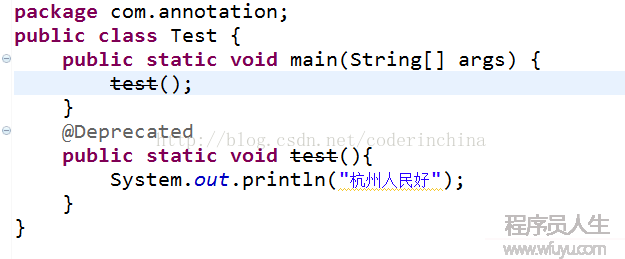
3:@SuppressWarnings中,用来拟制编译时正告信息,下面的代码也是很常见的
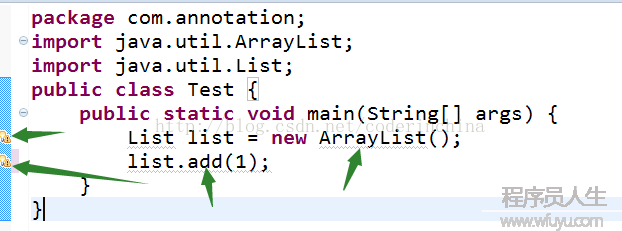
哪怎样修复呢?有2种,1种是依照提示去补充代码,比如List要添加泛型,表示这个list存储的是甚么类型的数据,还有1种就是使用注解,
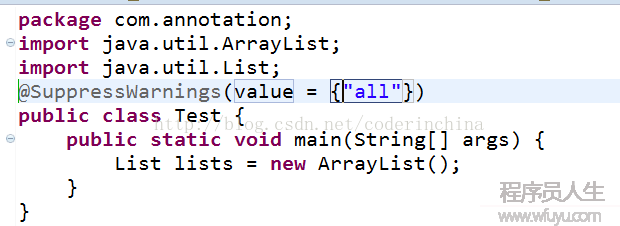
这个正告信息就没了,
放在变量前面也行:

在jdk源码中这个注解也到处都是
@Target({TYPE, FIELD, METHOD, PARAMETER, CONSTRUCTOR, LOCAL_VARIABLE}) @Retention(RetentionPolicy.SOURCE) public @interface SuppressWarnings { /** * The set of warnings that are to be suppressed by the compiler in the * annotated element. Duplicate names are permitted. The second and * successive occurrences of a name are ignored. The presence of * unrecognized warning names is <i>not</i> an error: Compilers must * ignore any warning names they do not recognize. They are, however, * free to emit a warning if an annotation contains an unrecognized * warning name. * * <p>Compiler vendors should document the warning names they support in * conjunction with this annotation type. They are encouraged to cooperate * to ensure that the same names work across multiple compilers. */ String[] value(); }
String[] value();我刚开始以为是方法,后来发现理解错了,value是参数名,String[]是参数类型,
如果想要使用这个注解,就必须最少添加1个参数,这些参数值都是定义好的,以下:
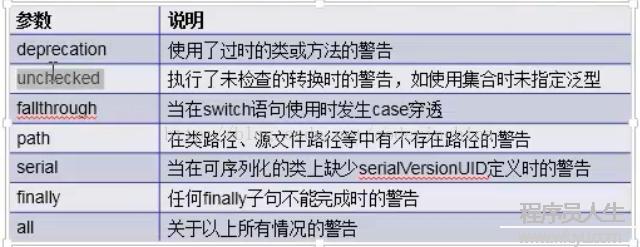
比如这么使用:
如果只有1个参数的话可以这么使用
@SuppressWarnings("all")
如果是多个参数的话,这么使用:
@SuppressWarnings(value={"all","unchecked"})
自定义注解:
使用@interface自定义注解时,自动继承了java.lang.annotatin.Annotation
@interface用来声明1个注解
格式:public @interface 注解名
其中每个方法实际上是声明1个配置参数,就和我们上面讲的SuppressWarnings1样,
方法的名称就是参数的名称
返回值类型就是参数的类型(返回值类型只能是基本类型,Class,String,enum)
可以通过default来声明参数的默许值
如果只有1个参数成员,1般参数名为value.
如果1个注解中甚么都没有的话就是1个标记注解,比如:
@Target(ElementType.METHOD) @Retention(RetentionPolicy.SOURCE) public @interface Override { }没有定义参数和参数类型,
在android studio中定义1个注解类:在这里选择,
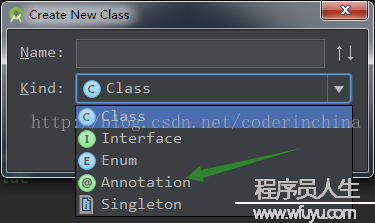
package com.annotation; /** * Created by admin on 2017/1/11. */ public @interface MyAnnotation { }它默许是继承了Annotation,就像你随意定义1个Person,它也是隐士的继承了Object类1样,
1般定义注解都要在这个注解上定义2个元注解,那末甚么是元注解呢?
元注解:
元注解的作用就是负责注解其他的注解,对注解进行描写,java定义了4个标注的meta-annotation类型,他们被用来对其他Annotation类型的说明,分别有以下4个:
@Target:用于描写注解的使用范围(也就是说注解可以被用在甚么地方),
public @interface Target { ElementType[] value(); }
它是有参数名和参数类型的,上面已说明了,在这就不描写了
@Retention:表示在甚么级别保存该注释信息,用于描写注解的生命周期
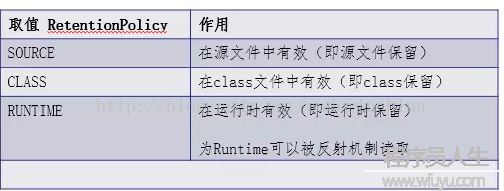
1般都是使用RUNTIME,由于你自定义注解肯定是希望通过反射在运行时读取啊,而前2者通知是在编译时期,如果使用了RUNTIME,那末就包括前2者,由于它生命周期最长,如果定义了前2者反射是读取不到的.
@Documented:Documented 注解表明这个注解应当被 javadoc工具记录. 默许情况下,javadoc是不包括注解的. 但如果声明注解时指定了 @Documented,则它会被 javadoc 之类的工具处理, 所以注解类型信息也会被包括在生成的文档中
现在在eclipse中如何演示生成1个文档:
第1步点击项目:选择Export
第2步:
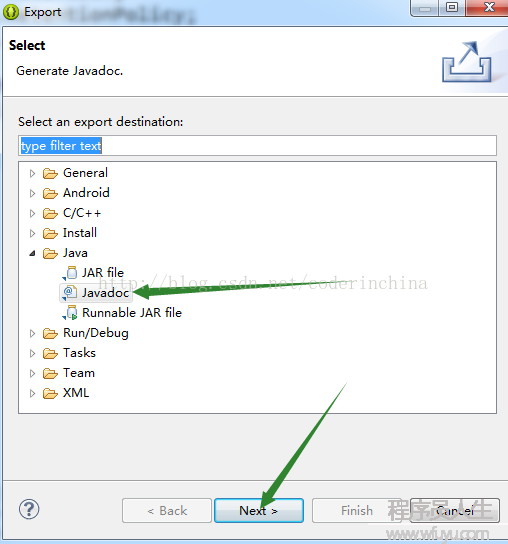
第3步:
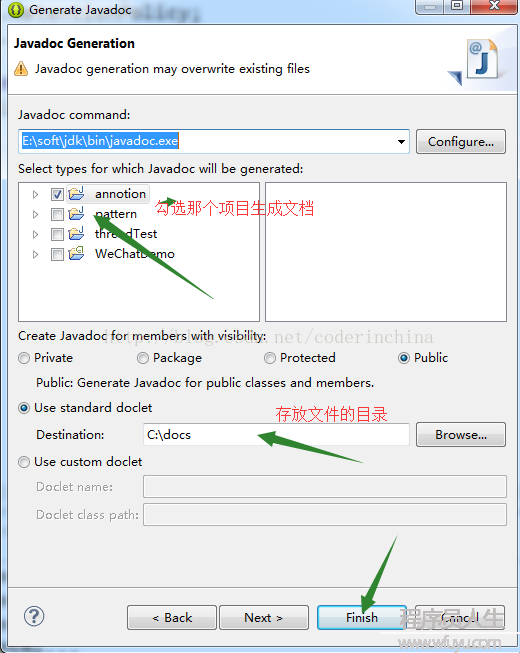
第4步:在eclipse下运行生成文档
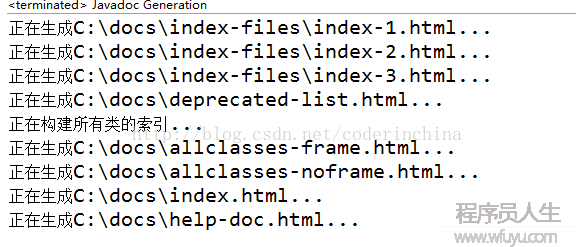
第5步:在之前选择寄存文档的目录中找到生成的文档:

看到这个相信大家都明白了,jdk中文或英文文档是否是有这个了,然后点击index.html查看

@Inherited:允许子类继承父类的注解
上面把元注解讲完了,现在自定义注解:
package com.annotation; import java.lang.annotation.ElementType; import java.lang.annotation.Retention; import java.lang.annotation.RetentionPolicy; import java.lang.annotation.Target; /** * Created by admin on 2017/1/11. */ @Target(ElementType.METHOD) @Retention(RetentionPolicy.RUNTIME) public @interface MyAnnotation { String name(); }
解释:

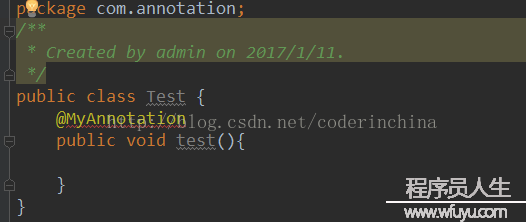
发现报错了,解决这类办法有2个方法
第1个方法:
设置默许值:
@Target(ElementType.METHOD) @Retention(RetentionPolicy.RUNTIME) public @interface MyAnnotation { String name() default ""; }
第2种方法:
public class Test { @MyAnnotation(name="zhou") public void test(){ } }这就是自定义注解了,我写的是1个简单的,其实复杂的也就是所谓的参数多点而已,
使用反射读取注解内容
写这个例子就是使用注解和反射知识动态的生成1条sql语句,现在很多框架估计也是这么干的,只是料想,没看过网上那些3方数据库框架的源码,
package com.annotation; /** * Created by admin on 2017/1/11. */ @UserAnnotion("table_user") public class User { @AttrsAnnotation(columnName = "id",type ="int",len = 10) private int id; @AttrsAnnotation(columnName = "name",type ="varchar",len = 10) private String name; public int getId() { return id; } public void setId(int id) { this.id = id; } public String getName() { return name; } public void setName(String name) { this.name = name; } }对类名进行注解跟表名进行xiangguan
package com.annotation; import java.lang.annotation.ElementType; import java.lang.annotation.Retention; import java.lang.annotation.RetentionPolicy; import java.lang.annotation.Target; /** * Created by admin on 2017/1/11. */ @Target(value= {ElementType.TYPE}) @Retention(RetentionPolicy.RUNTIME) public @interface UserAnnotion { String value();//与表名对应 }类中的属性和表字段进行相干联通过注解的方式
package com.annotation; import java.lang.annotation.ElementType; import java.lang.annotation.Retention; import java.lang.annotation.RetentionPolicy; import java.lang.annotation.Target; /** * 修饰表中属性的注解 * Created by admin on 2017/1/11. */ @Target(value= {ElementType.FIELD}) @Retention(RetentionPolicy.RUNTIME) public @interface AttrsAnnotation { String columnName() default ""; String type() default ""; int len() default 10; }终究动态的生成sql语句:
/** * 读取User中的数据 动态生成sql语句 */ public void table(){ try { Class clazz = Class.forName("com.annotation.User"); if(clazz!=null){ UserAnnotion userAnnotion = (UserAnnotion) clazz.getAnnotation(UserAnnotion.class); String table_name = userAnnotion.value();//获得表名 Field nameFiled = clazz.getDeclaredField("name"); Field idFiled = clazz.getDeclaredField("id"); AttrsAnnotation nameFiledAnnotation = nameFiled.getAnnotation(AttrsAnnotation.class); AttrsAnnotation idFiledAnnotation = idFiled.getAnnotation(AttrsAnnotation.class); String tabpPre = "CREATE TABLE IF NOT EXISTS "; String sql=tabpPre+table_name+"("+"_id INTEGER PRIMARY KEY AUTOINCREMENT"+","+nameFiledAnnotation.columnName()+" "+nameFiledAnnotation.type()+"("+nameFiledAnnotation.len()+")"+","+idFiledAnnotation.columnName()+" "+idFiledAnnotation.type()+")"; Log.e(TAG,"SQL="+sql); } } catch (ClassNotFoundException e) { e.printStackTrace(); } catch (NoSuchFieldException e) { e.printStackTrace(); } }结果:
CREATE TABLE IF NOT EXISTS table_user(_id INTEGER PRIMARY KEY AUTOINCREMENT,name varchar(10),id int)
如图调用:
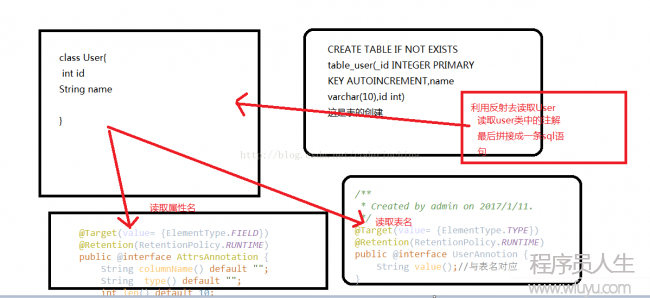
如果知道这些理论,以后看3方数据库框架应当轻松很多的,就写到这吧
